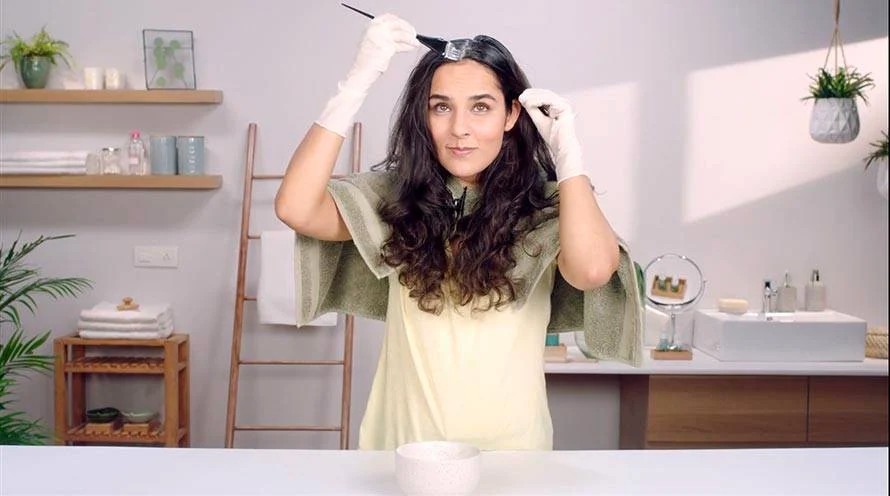Many people like changing their hair colour to keep up with the latest fashions. Others, on the other hand, do it in order to get a more balanced skin tone or to have their complexion seem more brightened overall. Going to the salon is not always an option, and as the days pass, the colour begins to fade and the roots begin to show through the hair. It becomes clear that there is a change in tone. So, in general, there’s a question in the mind that how to colour hair at home?
Home hair colouring isn’t quite as difficult as it may seem at first glance. Using this advice in conjunction with the stages that we will describe further down, you will get a professional-looking final result. All you will need is time, patience, and the correct items to achieve success. Fortunately, dying your hair at home is a simple process, particularly for those who have a single tone, and it only needs a few ingredients to get the desired result.
Many individuals fear dying their hair at home because they are concerned about whether the colour will set well, be even, and turn out as intended. Throughout this post, we will discuss the many ways and strategies that you may use to help you overcome your anxiety and be inspired to take active steps.
Hair colouring equipment for use at home
- Vaseline or baby oil may be used.
- Bowl
- Gloves made of plastic.
- Comb for your hair.
- Cap for the shower.
#ProTip
Make an appointment with a doctor/specialist to get tested for allergies.
Although it may seem to be a waste of time, you should absolutely do the skin test recommended on the tincture box’s label. After all, what’s the point of colouring your hair if you’re allergic to the dye? Simply put a little amount of dye to the back of your neck and examine to see whether the skin seems normal or inflamed after 24 hours.
If you experienced an adverse response to the product, discontinue usage and replace it with a different brand.
How to Colour Hair at Home? Step by Step Guide
- Plan ahead of time, at least 1 week prior, and treat your hair with masks; these may be natural or commercial masks that you can buy in beauty shops; I’m sure you have one laying around.
It is critical to keep the hair as hydrated and nourished as possible since the chemical aggression that it will be subjected to will be severe and will cause it to suffer. Consider the abrasion caused by the iron and dryer, as well as other factors.
In order to eliminate frizz and leave hair strong and visually healthy, nutrition and moisture are very vital in the hair’s health.
- The day before you want to dye it, make sure that the root is a bit oily so that it can protect the scalp; the ideal thing is to avoid washing it on that day; instead, you should wash it the day after you finish colouring it.
We suggest that you do not wash it for at least 1 or 2 days before you plan on colouring your hair. It depends on your hair type; if you have oily roots, one day without washing would be enough; if you have dry hair, two or three days would be great.
- To choosing a colour, keep in mind that you can only decrease or increase the original colour of your hair by a maximum of two shades; however, if you want to alter more shades, you need bleach your hair first so that the dye absorbs well, which means that the hair fibre will be more aggressive.
How many different colours of dye should you use? The length of your hair and the amount of colour you use will determine how long your hair will be; a box of dye will normally last you until you have medium-length hair, which is a little above the middle of your back.
- Even if you have long hair that is not plentiful and is of medium height, you may need to use a whole box and a half, as well as if you have long hair that is not abundant.
When it comes to long and plentiful hair, we recommend that you use two boxes; it is preferable to overdye rather than to stop halfway through the process.
- In any event, following the first time you colour your hair at home, you will be able to determine the proper precautions to take. Any remaining dye in the tube may be saved and used for the next dying session.
- Check that you have all of the necessary supplies before you begin dyeing your hair at home, including the boxes of dye, the container in which you will mix the mixtures, the brush with which you will apply the colour, gloves, a layer to protect your clothes (use an old shirt that you are not afraid of staining), bows or plastic clips to separate your hair (do not use metal clips because they can react with the dye).
- Untangle your hair and divide it into quadrants, which you must do while standing in front of a mirror for best results. Ideally, it should be divided into four sections, with a line running through the centre of each section and then each section divided into two sections by a horizontal line; there should be two sections above and two sections below. Make a bow to separate each section.
You must begin dyeing the hair from the root, taking each quadrant and, in turn, by wicks, starting at the base and working your way down to the ends.
Ensure that you use little bits or wicks to ensure that the colour gets to all of the sections. Proceed in this manner until you have finished with all of the hair.
- Additional words of wisdom: Is this the first time you’ve done this and you applied a lot of dye in the beginning but just a little amount at the end? Relax, grab a comb, and begin combing the hair from the root up. You will see how the extra colour is dragged, which you can then use to fill in the gaps where the dye was not applied.
- Follow the recommendations on the package and let the dye on for the amount of time specified. Then rinse as thoroughly as possible to remove any extra colour. We suggest that you use products designed specifically for coloured hair to help preserve the colour.
- Make use of a sealer that, in most cases, also has a conditioning effect. This helps to seal the hair fibre, allowing the colour to persist for a longer period of time, and they also include additional substances that assist to promote the health of the hair after the chemical procedure.
- Godrej hair colour shampoo is one of the instant hair colours that you can use. You just need to apply the Godrej hair colour shampoo for five minutes and wash it away. This hair colour shampoo consists of the essence of amla and shikakai that rejuvenates your hairs and keeps them healthy and lustrous.
After Colouring Your Hair at Home, Shampoo and Condition the Hair
With this article, It is hoped that the question How to colour Hair at home is properly addressed. Make sure to remove the colour from your hair by rinsing it out with the conditioner that came with the box (or by using your own colour-treated hair solution). Keep calm if a lot of colour runs off since this is only the residue from the scalp being removed. If necessary, repeat the process two or three times until the water runs clean. Use lukewarm water for this step. Invest in a hair-washing system designed specifically for coloured hair. This sulphate-free system, which is infused with elastin protein and quinoa, provides pure hydration and nutrients.

